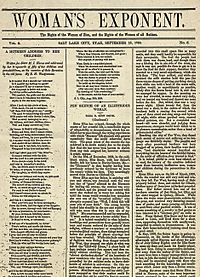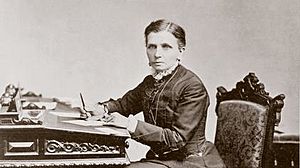Woman's Exponent facts for kids

September 15, 1880 issue
|
|
| Type | Periodical |
|---|---|
| Founded | 1872 |
| Language | English |
| Ceased publication | 1914 |
| Headquarters | Salt Lake City |
The Woman's Exponent was an important magazine for women. It started in 1872 and was connected to The Church of Jesus Christ of Latter-day Saints. This magazine shared articles that supported women's suffrage, which means women's right to vote. It also discussed a religious practice called plural marriage. Besides these topics, it featured poems and other writings.
Lula Greene Richards and Emmeline B. Wells were the main editors. The Exponent stopped publishing in 1914. It was known as the first long-lasting magazine for women's rights in the western United States. While it didn't have a direct follow-up, the Relief Society, a women's organization, started its own magazine, the Relief Society Magazine, in 1915.
Years later, in 1974, a new magazine called Exponent II began. It was started by a women's group in Massachusetts. This new publication was not part of the Church but was inspired by the original Woman's Exponent. It is still published today.
Contents
Why the Woman's Exponent Was Created
The Woman's Exponent was also known as A Utah Ladies' Journal. It was published in Salt Lake City from 1872 to 1914. Its main goals were to share good ideas and useful knowledge. It also aimed to "discuss every subject interesting and valuable to women."
People later said its purpose was to help and strengthen women of The Church of Jesus Christ of Latter-day Saints. It also aimed to teach others about the women in the Church. The magazine was started because Utah women felt they were being shown unfairly in other newspapers. They believed, "Who are so well able to speak for the women of Utah as the women of Utah themselves?" They wanted to represent themselves instead of being misrepresented.
How the Magazine Was Run
Even though it wasn't an official Church publication, Church members owned and ran the Exponent. It was closely connected to the Church's women's groups, especially the Relief Society. Church leaders approved of the magazine. It often shared news about Church events and essays on religious beliefs. However, the editors made their own decisions about what to publish.
What the Exponent Talked About
The Woman's Exponent covered many different subjects. It even shared different opinions on topics. It was a strong supporter of women's right to vote. It also supported plural marriage, which was a religious practice of the Church at that time.
Home, family, and the role of women were common topics. The Exponent said that a woman's place in the home was important. But it also encouraged women to do more than just stay at home. It often urged women to get an education. Lucinda Lee Dalton, an early supporter of women's rights, wrote for the magazine often.
Other Interesting Topics
The Exponent also published parts of The Woman's Bible by Elizabeth Cady Stanton. It included writings about the Mormon belief in Heavenly Mother. Besides religious, social, and political topics, the magazine had poems and stories. It also shared funny tidbits or wise sayings, and current news.
Recipes and tips for housekeeping were included. There were also notes on fashion. To help Utah become more financially independent, the Exponent encouraged women to buy only local products. Reports from Relief Society meetings and other groups, like young women's and primary groups, were often in the magazine. Women in the Relief Society were encouraged to subscribe and write for the paper.
The Woman's Exponent usually came out twice a month at first. Later, it was published once a month. Each issue was eight pages long. It was described as "well filled with reading matter."
In 1888, about 4,000 copies were printed. Many more people likely read it because the Exponent was used in women's meetings. It was also shared with other newspapers outside of Utah. People believed it had a lot of influence in Utah. Other journals often quoted from it. The back page of the newspaper had advertisements. These included ads from the Church President telling women to open their own bank accounts. Other ads were for clothes, silkworms, and classes to become a midwife.
The Story of the Exponent
Edward L. Sloan, the editor of the Salt Lake Herald newspaper, first wanted to add a women's section to his paper. When his staff didn't support the idea, he decided to start the Exponent as a separate magazine. He had heard that the Relief Society wanted a journal for women.
Sloan asked Louisa Lula Greene to be the editor. She agreed after getting approval from her great-uncle, Brigham Young. He was the president of the Church. He gave her this job as a special assignment. Greene moved to Salt Lake City in April 1872. She first worked from a room in another great-uncle's house. Later, she moved to a special office with living space. The first issue of the Woman's Exponent was published on June 1, 1872.
Emmeline B. Wells joined Greene as a co-editor in December 1875. Wells later became the general president of the Relief Society. They worked together until Greene decided to spend more time with her family in July 1877. Later, Wells's daughter, Annie Wells Cannon, became an associate editor in June 1905. Both Wells and her daughter continued to edit the magazine until it closed.
Why the Exponent Ended
The magazine started to have money problems in the late 1800s or early 1900s. Wells tried to get the Relief Society to make the newspaper its official publication, but she was not successful. The paper had to close in February 1914. That month, The Salt Lake Tribune reported that the Exponent was "to give way to what is hoped to be a larger and more modern [publication], but as yet nothing has been done." The Relief Society Magazine, a different and official Church magazine, began in January 1915.
Exponent II: A New Chapter
Exponent II is described by its creators as a "spiritual descendant" of the original Woman's Exponent. This new independent magazine was started by a women's group in Massachusetts in 1974. It is published four times a year. Today, it is the longest-running independent publication for Latter-day Saint women.


